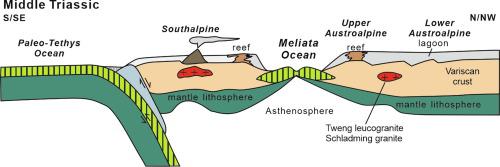Gondwana Research ( IF 7.2 ) Pub Date : 2022-05-10 , DOI: 10.1016/j.gr.2022.05.006 Qianwen Huang 1, 2, 3, 4 , Franz Neubauer 3 , Yongjiang Liu 1, 2, 4 , Johann Genser 3 , Qingbin Guan 1, 2 , Ruihong Chang 3 , Sihua Yuan 3, 5 , Shengyao Yu 1, 2

|
Permian magmatic activity is widespread in the Austroalpine Unit stretching from Eastern Alps to the Western Carpathians and Pannonian region, the link between magmatism and the subduction of Paleo-Tethys Ocean is not well constrained up to now. Here, we report, for the first time, a Middle Triassic granite in the Austroalpine basement, which is at odds with a common opinion of the passive margin setting of this unit. The Tweng and Schladming Complexes representing a Neoproterozoic to Early Paleozoic magmatic arc were intruded by Permian and Triassic granites, related to back-arc extension triggered by the subduction of Paleo-Tethys Ocean. To reveal the tectonic affinity of these granitic rocks, we systematically analyzed their zircon geochronology and whole-rock geochemistry. The zircon U-Pb data show that the Tweng granitic gneisses and leucogranites were formed at 261 Ma and 244 Ma, respectively. The Schladming granitic gneisses were formed at 244–241 Ma, their εHf(t) values (-0.9 to + 5.6) indicate their derivation from the lower crust and involved continent material. Geochemically, the granitic rocks from the Tweng Complexes have common features with subduction-related continental arc andesitic affinity. The granitic gneisses of Tweng and Schladming Complexes show A-type granite-affinity with high zircon crystallization temperatures of 784–835 ℃ and 781–818 ℃, respectively, whereas the Tweng leucogranites exhibit I-type granite characteristics and low zircon crystallization temperatures of 720–724 ℃. The geochemical features suggest that the Tweng granitic gneisses and leucogranites originated from the lower crust, while the Tweng leucogranites are explained by remelting of Tweng granitic gneisses, and interacted with subduction-related fluids. Therefore, we propose that the Permian-Triassic granitic rocks of Tweng and Schladming Complexes were formed in a back-arc setting during the subduction of the Paleo-Tethys Ocean, which finally resulted in the opening of the Meliata oceanic back-arc basin during Middle Triassic times.
中文翻译:

斯拉德明杂岩体(南高山基底)的二叠纪-三叠纪花岗岩:对东阿尔卑斯山古特提斯洋俯冲的意义
二叠纪岩浆活动在从东阿尔卑斯山延伸到西喀尔巴阡山脉和潘诺尼亚地区的南高山单元中普遍存在,岩浆活动与古特提斯洋俯冲之间的联系至今没有得到很好的约束。在这里,我们首次报道了位于南高山基底的中三叠统花岗岩,这与对该单元被动边缘设置的普遍看法不一致。代表新元古代至早古生代岩浆弧的特文和施拉德明杂岩被二叠纪和三叠纪花岗岩侵入,与古特提斯洋俯冲引发的弧后伸展有关。为了揭示这些花岗质岩石的构造亲和力,我们系统地分析了它们的锆石年代学和全岩地球化学。锆石U-Pb数据表明,Tweng花岗片麻岩和淡色花岗岩分别形成于261 Ma和244 Ma。斯拉德明花岗片麻岩形成于 244-241 Ma,它们的 ε氢氟酸(t) 值(-0.9 到 + 5.6)表明它们来自下地壳和涉及的大陆物质。在地球化学上,来自 Tweng 杂岩的花岗质岩石具有与俯冲相关的大陆弧安山岩亲和力的共同特征。Tweng 和 Schladming 杂岩的花岗片麻岩表现出 A 型花岗岩亲和性,锆石结晶温度高,分别为 784-835 ℃ 和 781-818 ℃,而 Tweng 淡色花岗岩表现出 I 型花岗岩特征,锆石结晶温度低 720 –724℃。地球化学特征表明Tweng花岗片麻岩和淡色花岗岩起源于下地壳,而Tweng淡色花岗岩是由Tweng花岗片麻岩的重熔解释的,并与俯冲相关流体相互作用。所以,










































 京公网安备 11010802027423号
京公网安备 11010802027423号